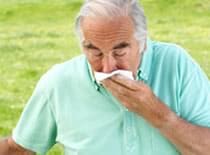What is a Pap smear?
A Pap smear (also known as the Pap test) is a medical procedure in which a sample of cells from a woman's cervix (the end of the uterus that extends into the vagina) is collected and spread (smeared) on a microscope slide. The cells are examined under a microscope in order to look for pre-malignant (before-cancer) or malignant (cancer) changes.
A Pap smear is a simple, quick, and relatively painless screening test. Its specificity - which means its ability to avoid classifying a normal smear as abnormal (a "false positive" result) - while very good, is not perfect. The sensitivity of a Pap smear - which means its ability to detect every single abnormality -- while good, is also not perfect, and some "false negative" results (in which abnormalities are present but not detected by the test) will occur. Thus, a few women develop cervical cancer despite having regular Pap screening.
In the vast majority of cases, a Pap test does identify minor cellular abnormalities before they have had a chance to become malignant and at a point when the condition is most easily treatable. The Pap smear is not intended to detect other forms of cancer such as those of the ovary, vagina, or uterus. Cancer of these organs may be discovered during the course of the gynecologic (pelvic) exam, which usually is done at the same time as the Pap smear.
Who should have a Pap smear?
Pregnancy does not prevent a woman from having a Pap smear. Pap smears can be safely done during pregnancy. Pap smear testing is not indicated for women who have had a hysterectomy (with removal of the cervix) for benign conditions. Women who have had a hysterectomy in which the cervix is not removed, called subtotal hysterectomy, should continue screening following the same guidelines as women who have not had a hysterectomy.
The screening guidelines of several key medical organizations are summarized below.
American Cancer Society 2004
When to start Pap smear testing
3 years after vaginal intercourse, no later than age 21
Frequency of Pap smear testing
Yearly with exceptions:
every 2 years if liquid-based kit
every 2-3 years if three normal tests in a row in women >30 years old
At what age to stop having Pap smears
Total hysterectomy for benign disease
> 70 years old with at least three normal Pap smear results and no abnormal Pap results in the last 10 year
American College of Obstetrics and Gynecology
When to start Pap smear testing
3 years after first sexual intercourse or age 21, whichever comes first.
Frequency of Pap smear testing
Yearly until age 30 years. Beginning at age 30, if three normal annual Pap results, can do a Pap alone every 2-3 years
At what age to stop having Pap smears
Difficult to set an upper age limit-postmenopausal women screened within the prior 2-3 years have a very low risk of developing abnormal Pap smears.
Which women are at increased risk for having an abnormal Pap smear?
A number of risk factors have been identified for the development of cervical cancer and precancerous changes in the cervix.
HPV: The principal risk factor is infection with the genital wart virus, also called the human
papillomavirus (HPV), although most women with HPV infection do not get cervical cancer. (See below for details). About 95%-100% of cervical cancers are related to HPV infection. Some women are more likely to have abnormal Pap smears than other women.
Smoking: One common risk factor for premalignant and malignant changes in the cervix is smoking. Although smoking is associated with many different cancers, many women do not realize that smoking is strongly linked to cervical cancer. Smoking increased the risk of cervical cancer about two to four fold.
Weakened immune system: Women whose immune systems are weakened or have become weakened by medications (for example, those taken after an organ transplant) also have a higher risk of precancerous changes in the cervix.
Medications: Women whose mothers took the drug diethylstilbestrol (DES) during preg
nancy also are at increased risk.
Other risk factors: Other risk factors for precancerous changes in the cervix and an abnormal Pap testing include having multiple sexual partners and becoming sexually active at a young age.
How is a Pap smear done?
A woman should have a Pap smear when she is not menstruating. The best time for screening is between 10 and 20 days after the first day of her menstrual period. For about two days before testing, a woman should avoid douching or using spermicidal foams, creams, or jellies or vaginal medicines (except as directed by a physician). These agents may wash away or hide any abnormal cervical cells.
A Pap smear can be done in a doctor's office, a clinic, or a hospital by either a physician or other specially trained health care professional, such as a physician assistant, a nurse practitioner, or a nurse midwife.
With the woman positioned on her back, the clinician will often first examine the outside of the patient's genital and rectal areas, including the urethra (the opening where urine leaves the body), to assure that they look normal.

A speculum is then inserted into the vaginal area (the birth canal). (A speculum is an instrument that allows the vagina and the cervix to be viewed and examined.)
A cotton swab is sometimes used to clear away mucus that might interfere with an optimal sample.

A small brush called a cervical brush is then inserted into the opening of the cervix (the cervical os) and twirled around to collect a sample of cells. Because this sample comes from inside the cervix, is called the endocervical sample ("endo" meaning inside).
A second sample is also collected as part of the Pap smear and is called the ectocervical sample ("ecto" meaning outside).These cells are collected from a scraping of the area surrounding, but not entering, the cervical os.
Both the endocervical and the ectocervical samples are gently smeared on a glass slide and a fixative (a preservative) is used to prepare the cells on the slide for laboratory evalua tion.
A bimanual (both hands) pelvic exam usually follows the collection of the two samples for the Pap smear. The bimanual examination involves the physician or health care practitioner inserting two fingers of one hand inside the vaginal canal while feeling the ovariesand uterus with the other hand on top of the abdomen (belly).
The results of the Pap smear are usually available within two to three weeks. At the end of Pap smear testing, each woman should ask how she should expect to be informed about the results of her Pap smear. If a woman has not learned of her results after a month, she should contact her health care practitioner's office.
What are the risks of having a Pap smear?
There are absolutely no known medical risks associated with Pap smear screening. (However, there are medical risks from not having a Pap smear.)
How is a Pap smear read (analyzed)?
Pap smear analysis and reports are all based on a medical terminology system called The Bethesda System. The system was developed (at the National Institutes of Health (
NIH) in Bethesda, Maryland) to encourage all medical professionals analyzing Pap smears to use the same reporting system. Standardization reduces the possibility that different laboratories might report different results for the same smear. Standardization and uniform terminology also make Pap smear reports less confusing for the clinicians who request the tests and for their women patients.
The Bethesda System was the outcome of a National Cancer Institute workshop that was held in 1988 in an effort to standardize Pap reports. The guidelines address many aspects of Pap smear testing and its results. In 2001, the guidelines were revised and improved. Acceptance of the Bethesda reporting system in the United States is virtually universal.
What information is included on a Pap smear report?
The first items on a Pap smear report are for purposes of identification. The report is expected to have the name of the woman, the name of the pathologist and/or the cytotechnologist who read the smear, the source of the specimen (in this case, the cervix), and the date of the last menstrual period of the woman.
The Pap smear report should also include the following:
A description of the woman's menstrual status (for example, "menopausal" (no longer menstruating) or "regular menstrual periods")
The woman's relevant medical history (example, "history of genital warts")
The number of slides (either one or two, depending on the health care practitioner's routine practice)
A description of the specimen adequacy (whether the sample is satisfactory for interpretation)
The final diagnosis (for example, "within normal limits")
The recommendation for follow-up (for example, "recommend routine follow-up" or "recommend repeat smear")
Why is a woman's menstrual status important for the Pap smear?
A woman who is menstruating sheds cells from the lining of her uterus called endometrial cells. If these cells are seen on the Pap smear of a menstruating woman, the report may note "endometrial cells, cytologically benign, in a menstruating woman. The comment that cells are "cytologically benign" means that they do appear not to be malignant (cancerous) cells. A comment of this nature is absolutely not worrisome since a menstruating woman may be expected to shed such cells.
However, if a woman is menopausal (no longer menstruating) she would not be expected to be shedding cells from the uterine lining. Therefore, endometrial cells on a Pap report might be indicative of an abnormal thickening of the endometrium, the lining of the uterus. The Pap smear is not specifically designed to detect such an abnormality. Nonetheless, if these cells are noted in a non-menstruating woman, her physician should attempt to determine the cause of the shedding of the endometrial cells.
Sometimes, the cause is endometrial hyperplasia, a precancerous condition of the uterine lining, which can be detected by a relatively simple office procedure called an endometrial biopsy. Sometimes, menopausal hormone therapy can cause shedding of endometrial cells that appear on a Pap smear. The pattern of bleeding, the exact type of hormone therapy, and the individual woman's health history are the three components that guide the physician to know whether and what type of further evaluation is necessary.
Why is a woman's past Pap smear history pertinent?
If a woman has had a history of a cellular abnormality on a previous Pap smear, it is important for her to inform the health care practitioner performing the current Pap smear. The patient should provide the details of any previous problems and treatments so that this information can be noted on the lab form. The past history of the woman helps the person who is reading (interpreting) the current Pap smear, because a particular abnormality on previous screening alerts the health care practitioner to look more carefully for specific findings on the current Pap smear.
When might a Pap smear not be adequate for interpretation?
It is a requirement that the report comment on the adequacy of the smear sample for Pap analysis. If the sample is inadequate, the report details the reason. Examples of problems that might be listed under "sample adequacy" include "drying artifact" or "excessive blood." These comments refer to factors that the person analyzing the smear feels may have interfered with his or her ability to interpret the sample.
Sometimes, a Pap smear report will read "unsatisfactory due to excessive inflammation." Inflammation that is present in the woman's cervical area may make it difficult to interpret the Pap smear. Examples of causes of inflammation might include infections or irritation. Inflammation is a common finding on pap smears. If it is severe, your doctor may want to try to determine the cause of the inflammation. In many cases, a repeat pap smear is recommended to determine if the inflammation has resolved and to obtain a sample that is adequate for interpretation.
How is the final Pap smear diagnosis made?
The final Pap smear diagnosis is based on three determining factors:
The patient's history: The reader (the person reading the smear) takes into account the woman's history as noted on the lab request by the clinician performing the smear.
Sample adequacy: The reader then decides whether the sample was adequate for interpretation.
The presence or absence of cellular abnormalities: The reader then notes whether cellular abnormalities were seen on the slides. If the appearance of the Pap smear does not seem to coincide with the woman's clinical history, a comment may also be made to that effect.
The final diagnosis is a short statement that summarizes what the reader has found. Examples of final diagnoses include:
Within normal limits;
Absence of endocervical cells on the Pap smear;
Unreliable Pap smear due to inflammation;
Atypical squamous cells of undetermined significance (ASCUS);
Low-grade squamous intraepithelial lesion (LSIL); or
High-grade squamous intraepithelial lesion (HSIL).
There may also be additional comments such as "low-grade squamous intraepithelial lesion (LSIL) with human papilloma virus."
What are the possible recommendations for follow-up after a Pap smear?
Once the final diagnosis has been made, the follow-up recommendation informs you what the appropriate next step(s) might be. For example, if the final diagnosis states that the smear was "within normal limits," the appropriate follow-up might be "recommend routine follow-up."
An abnormal Pap smear is one in which the laboratory interprets the cellular changes to be different from those normally seen on a healthy cervix. There are a number of possible follow-up scenarios for an abnormal Pap smear.
Absence of endocervical cells on the Pap smear: There is a particular area wherein the cells lining the vagina change to the endocervical cells that characterize the inside of the cervix. This is called the "transition zone" and is the target of the endocervical sample. However, it may be so far up inside the cervix that the Pap smear sampling instrument simply cannot reach that high. To further complicate the situation, the transition zone in a woman migrates (changes its position) at different times in her life and under different conditions. Sometimes, the transition zone may be less accessible to the Pap brush or the cervical os (opening to the cervix) cannot be seen well enough to obtain an adequate sample. Sometimes, the reason for the absence of endocervical cells on the Pap smear is simply not evident.
Regardless, if the cause of the absent endocervical cells is known or unknown, the situation must be evaluated by the physician. In everyday practice, an appropriate response to the absence of endocervical cells is to redo the Pap smear, but also to take the woman's prior history into account in determining the timing. If the woman has had regular Pap smears, has never had an abnormal one, and does not have an added risk factor for an abnormal Pap smear, then the clinician will often wait a year before repeating the smear. If the woman does have risk factors, the clinician will often elect to repeat the smear sooner.
Unreliable Pap smear due to inflammation: If severe inflammation is present, its cause(s) must be investigated. The physician's goals are to identify the cause of inflammation and to treat and resolve the condition, if possible. Untreated inflammation can have consequences for the woman as well as her sexual partner(s).
Sometimes, the woman's medical history will shed light on the cause of inflammation. For example, a woman may complain of irritation, dryness, or pain in her vaginal area. The inflammation can then be verified by the physician during a pelvic exam. The vaginal irritation may be caused by a lack of estrogen, such as occurs after menopause when the ovaries stop producing this hormone. This lack of estrogen tends to make the vaginal walls irritated and red. If a woman has this condition and it is related to an estrogen deficiency (called "atrophic vaginitis" and usually described on the Pap smear report as "atrophic changes"), her physician may recommend a trial of topical (locally- applied) vaginal estrogen (cream, vaginal estrogen tablets, vaginal estrogen ring) to hopefully heal the inflammation. The Pap smear is then repeated.
In summary, the physician will use clinical judgment in terms of the specific follow-up after a Pap smear that reports inflammation.
Atypical squamous cells of undetermined significance (ASCUS): Sometimes, atypical squamous cells of undetermined significance (also called "ASCUS"), is the determination written on the Pap report. This is the mildest form of cellular abnormality on the spectrum of cells ranging from normal to cancerous. ASCUS means that the cells appear abnormal but are not malignant.
"Of undetermined significance" means that the atypical-appearing cells may be the end res
ult of a number of different types of injuries to the cervix. For example, the human papilloma virus (HPV) could be the cause of ASCUS. Most instances of ASCUS (80%-90%) resolve spontaneously (by themselves without specific medical intervention or treatment). This is the reason why many women with ASCUS readings will be asked to simply have a repeat Pap smear in 4 to 6 months. The expectation is that regardless of the original cause of the ASCUS, it will be resolved by the time the Pap smear is repeated. If not, the cause of the ASCUS can still be identified and treated if ASCUS is again observed on the repeat Pap smear 4 to 6 months later. This standard recommendation of serial Pap smears - repeating the Pap smear in 4 to 6 months - is made unless the physician has a concern that the woman is not willing or able to return for a repeat Pap smear. In these cases, a colposcopy (see
below) may be done without waiting to repeat the Pap smear.
The third approach to ASCUS (besides serial Pap testing and immediate colposcopy) is called reflex HPV testing. Reflex HPV testing refers to a process in which the HPV test is only performed if the Pap smear result is abnormal. If the Pap smear result is normal, it is not performed. For reflex testing to be possible, a liquid-based Pap testing kit is required, which allows the lab to store the sample until the Pap smear result tells them whether the HPV test will be necessary or not. Not all facilities have access to liquid-based cytology kits. If repeat smears are to be done for monitoring, the testing needs to be done every 4 to 6 months for 2 years until there have been three consecutive normal smears, at which time routine screening can be resumed. The Pap smears, however, must not only be negative, but also satisfactory for interpretation, according to National Cancer Institute Workshop Guidelines.
The irritation of the genital area that accompanies menopause can trigger ASCUS by causing inflammation. If the physician suspects that this is the cause of ASCUS, he or she may prescribe intravaginal estrogen (local estrogen, such as a vaginal ring, vaginal cream, or vaginal estrogen tablets) and repeat the Pap smear in 4 to 6 months to confirm that the inflammation is resolved. If the inflammation persists, colposcopy will be necessary. Sometimes, the ASCUS reading is accompanied by a comment to the effect that the Pap smear reader thinks there may be a suggestion of dysplasia (abnormally dividing or abnormal appearing cells), often worded as "favor dysplasia." In this case, the ASCUS is generally not monitored over time but rather treated as if it is dysplasia (see discussion below). Similarly, a woman who has a suppressed immune system is not a good candidate for serial Pap smear tests because she is at higher risk of serious abnormalities. Therefore, she should undergo colposcopy instead of serial Pap smears. It is evident from this discussion that many factors go into a physician's decision regarding which of the three treatment options to recommend to an individual woman.
Low-grade squamous intraepithelial lesion (LSIL): A more serious cellular abnormality is low-grade squamous intraepithelial lesion (LSIL). A reading of LSIL is a reason for immediate further investigation because it is more abnormal than ASCUS. Fifteen to 30% of women who have this abnormality on Pap testing will have a more serious abnormality on biopsy of the cervix. Thus, all women with LSIL are recommended to undergo colposcopy. On the brighter side, even LSIL spontaneously returns to normal without therapy in many women within several months. For that reason, if the initial colposcopy and biopsy results are favorable, serial Pap smears every 4 to 6 months may be recommended, after which a return to normal screening is possible if there are three negative, consecutive, satisfactory Pap smears.
High-grade squamous intraepithelial lesion (HSIL): The most severe cellular abnormality that is not actually cancer is high-grade squamous intraepithelial lesion (HSIL). A finding of HSIL unquestionably requires prompt treatment.
Women with HSIL have a 70%-75% chance of having a more serious abnormality (CIN 2,3 see below) on biopsy of the cervix, and a 1%-2% chance of having actual cervical cancer on biopsy of the cervix. Therefore, colposcopy is undoubtedly the routine recommendation for all women with HSIL.
Cervical intraepithelial neoplasia (CIN): This is the most severe form of high-grade squamous intraepithelial lesion (HSIL). A neoplasia is within the realm of cancer. Type 1 CIN is "low grade," or less serious than Type 2, 3 CIN (high-grade). The diagnosis of a cervical intraepithelial neoplasia (CIN) on a woman's Pap smear means that she needs to be evaluated and treated as soon as possible by a qualified physician.
Carcinoma in situ: This diagnosis is also a form of high-grade squamous intraepithelial lesion (HSIL). A reading of "carcinoma in situ" on a Pap smear report means there is cervical cancer present. However, the cancer is "in situ," which means that it appears to be limited to the cervix and not to have invaded other tissues
What treatments are available if a Pap smear is abnormal?
If a Pap smear is interpreted as abnormal, there are a number of different management and treatment options including colposcopy, conization, cryocauterization, laser therapy, andlarge-loop excision of the transformation zone.
All of these procedures have essentially the same overall cure rate of over 90%. However, the procedures do vary considerably in a number of other respects and so will be discussed separately.

Colposcopy: Colposcopy is a procedure that allows the physician to take a closer look at the cervix. The colposcope is essentially a magnifying glass for the cervix. For colposcopy to be adequate, the whole cervical lesion, as well as the whole transformation zone (the transition between the vagina-like lining and the uterus-like lining), must be seen.
During colposcopy, the cervix is cleaned and soaked with 3% acetic acid. This acid not only cleans the surface of the cervix but it also allows cellular abnormalities to show up as white areas (called acetowhite epithelium or acetowhite lesions).
If suspicious areas of cervical tissue are seen during colposcopy, a biopsy (tissue sampling) is often done. The sample is sent to the laboratory for analysis by a pathologist and the biopsy results determine the next step in the treatment.
The procedure is essentially painless and quite simple, usually taking only several minutes to perform. Generally, the woman is instructed not to have intercourse, douche, or use tampons for about a week afterwards if a biopsy is done. Pregnancy is not a contraindication to colposcopy. Colposcopy can adequately evaluate 90% of women who have abnormal Pap smear results.
In unusual circumstances, colposcopy does not allow an adequate view of the cervix and another procedure called conization is necessary in order to obtain a tissue biopsy.
Conization: This is still the standard method to which all other methods are compared. Conization allows the entire area of abnormal tissue to be removed and provides the maximum amount of cervical tissue for laboratory evaluation to rule out the presence of invasive cancer. After the cervical area is visualized, generally by colposcopy, a cone-shaped specimen of tissue (perhaps 1/2-1 inch long and 3/4 inch wide) is taken from around the endocervical canal.
Conization is usually done on an out-patient basis under anesthesia in a hospital or surgical facility. For three weeks after the procedure, the woman needs to avoid douching and using tampons and refrain from sexual intercourse.
Cure rates close to 100% are achieved with conization as long as the cells along the margins of treatment are normal.
With conization, there are associated risks from anesthesia and postoperative hemorrhage (bleeding-in about 10% of cases) as well as possible future adverse effects on fertility. Conization is generally performed only on women who have had unsatisfactory colposcopy results, have adenocarcinoma in situ (a diagnosis of cancer) already, or whose Pap smears suggest they may have some invasion of cancer into the nearby tissue.
Hysterectomy (surgical removal of the uterus and the cervix) for non-cancerous abnormal Pap smears is now rarely done. A hysterectomy is appropriate only for those women who are finished with childbearing and have severe pre-cancerous abnormalities that have persisted despite other treatments. It may also be appropriate for women with certain specific findings after conization.
Cryocauterization: Cryocauterization is a simple and safe procedure. A probe, called a cryoprobe, is first cooled by carbon dioxide and then touched to the abnormal cervical area. This freezes and kills the cells, resulting in the sloughing of the abnormal tissue.
A woman undergoing cryocauterization can expect a watery vaginal discharge for several weeks after the procedure.
Laser therapy: Laser therapy makes use of the principle that laser light can be produced by electricity running through gas. In the treatment of cervical lesions, the gas is usually carbon dioxide. This type of laser can instantly boil water and therefore can also be used to kill and vaporize cells.
When a laser beam (using a tiny wand called a micromanipulator) is directed into the cervix at an area of abnormal cervical tissue, the light energy is converted to heat, which in turn causes cell death, as occurs with cryocauterization. However, the laser apparatus is expensive, and its use requires more skill than other treatment options, such as cryocauterization. The procedure is also painful and generally requires general anesthesia.
The benefit of laser therapy is that it may cause less cervical scarring as compared to cryocauterization. This in turn may mean that, should the woman need colposcopy in the future, the chances of adequately viewing her cervix may be better after laser therapy.
Large-loop excision (LEEP) of the transformation zone: Large-loop excision of the transformation zone (LEEP) removes the cervical transformation zone (the area where the vaginal-type lining changes to the uterine-type lining) using a thin-wire loop to administer electrocautery. It allows samples to be collected for additional tissue analysis and can be performed in the office under local anesthesia.
Specialized (more frequent) follow-up is necessary after LEEP. This follow-up includes Pap smears, colposcopy, and sometimes other techniques. When there is no more evidence of abnormal cervical tissue, it may be possible to resume annual screening Pap smears.
What is the follow-up after treatment for an abnormal Pap smear?
Follow-up is crucial after treatment for an abnormal Pap test. Women who have undergone any one of the above-described treatment procedures require special follow-up schedules. They must be evaluated and checked until the physician is fully convinced that routine Pap smears can be resumed.
What is the current status of human papilloma virus (HPV) typing?
HPV is a sexually transmitted virus that may be spread from one person to another even when the genital sores are not visible. Many sexually active people are carriers of HPV, very often without even knowing they are carriers. It is estimated that up to 60% of sexually active women harbor this virus on their cervix or in their vaginal area. It is not unusual for a woman to be unaware that she has HPV - only to find out that her Pap smear shows evidence of HPV.
HPV is not curable, although the cellular damage it causes is generally treatable and a vaccine against the four most commonly found HPV types is available. A woman with HPV needs careful and regular long-term medical follow-up to watch for any resulting HPV-associated pre-cancerous cellular changes.
There are over 70 different strains of HPV virus. Based on the observation that certain strains of HPV (for example, types 16 and 18) are more likely to be associated with cervical cancer, some people have advocated testing HPV infected women in order to identify their specific strain of HPV. Following an abnormal Pap smear, this information would then be used to help select the specific treatment strategy. In other words, a physician would more aggressively treat a woman with an abnormal Pap smear if she tests positive for an HPV type that is more likely to be associated with the development of cervical cancer.
However, even the so-called "low-risk" HPV strains can still be associated with cervical cancer at some time in the future and not all of the high-risk HPV strain abnormalities will necessarily result in cervical cancer. Furthermore, the HPV typing is expensive. The main use of HPV testing in screening for cervical cancer is for determination of treatment and follow-up recommendations for women with Pap smears interpreted as atypical squamous cells of undetermined significance (ASC-US) . Those with positive tests for high risk HPV types and an ASC-US smear are referred for further evaluation.
HPV testing along with Pap screening (a combined test) was approved for primary screening for cervical cancer by the U.S. Food and Drug Administration (FDA) in 2003. This combined testing has been used as an alternative screening test for low risk women aged 30 and over at intervals of three years or greater.
When should women start and stop having Pap smears, and how often should Pap smears be performed?
The table summarizes the consensus of all the major organizations regarding these important questions. The key points of the table are as follows:
All the guidelines agree that Pap smears should be started within 3 years of first sexual activity or age 21, whichever comes first.
There are minor differences in the recommendations for the frequency and age at which to stop Pap smears.
Older women who have had many normal Pap smears in a row and have been regularly screened are highly unlikely to have an abnormal Pap smear. These findings point to stopping Pap smears in older women, as reflected by several of the guidelines in the Table.
Women who have had a total hysterectomy for a benign condition no longer have a cervix, and thus do not derive any benefit from screening for cervical cancer.
In contrast, women who have had a subtotal hysterectomy still have a cervix, and thus should be screened according to the recommendations of women who have not had a hysterectomy.
Women who have had a hysterectomy for abnormal Pap smears have their own special recommendations.
Special situations may impact the frequency of screening. For example, women who have had cervical cancer, exposure to diethylstilbestrol, or a compromised immune system (as with HIV infection, for example) should continue annual screening as long as they are in reasonably good health. Women who have had a hysterectomy for CIN2 or CIN3 (a type of abnormal Pap smear) should be screened until they have had three normal Pap smears, (and if no abnormal Paps show up in 10 years, they can stop having Pap tests).
What is the current status of the newer Pap smear technologies?
New technologies have been developed to try to circumvent the problem of false-negative Pap smears. False-negative results occur when a disease or condition is present but the test does not detect it. False-negative Pap smears (slides with abnormal cells judged to be "normal") are estimated to be between 5% and 30%.
The new techniques consist of alternative ways to prepare and read Pap smears. In one new preparation method known as liquid-based cytology, cervical cells are obtained as usual but a new technique is used to prepare the slides for analysis. The physician puts the cell sample into a vial of liquid preservative. The cells are then sent to the laboratory where they are filtered and spread on glass slides. This method removes any contamination from blood or mucous.
Prepared slides are usually read by cytotechnologists who examine thousands of slides under a microscope every day. This exhausting process may be subject to human error. Computer systems are now being developed to assist by providing an automated analysis of slides. Slides containing abnormally appearing cervical cells can first be automatically identified and then subjected to a second, manual re-screening.
Recent guidelines are conflicting as to whether to recommend the new technologies because sound scientific research is not available on which to base a thoughtful recommendation. Besides being more expensive, the underlying problem is that the new technologies (such as liquid-based cytology) have never been proven to decrease mortality from cervical cancer as compared to conventional Pap testing. In addition, even if future research shows that more cases of cervical cancer are detected with the new technologies versus the conventional Pap testing, there may be too many "false positive" cases in which women are labeled to have abnormal Pap smears when they are perfectly normal. This last point is critical. The information must be gathered before rational recommendations can be widely instituted.
With Pap smears so available, why are women still dying of cervical cancer?
It is critically important to recognize that the women who are at highest risk for abnormal Pap smear testing are those who are not getting regular Pap testing. Therefore, it follows that in order to improve overall cervical cancer screening, women who are not getting regular Pap smears should be educated about and offered Pap testing. These under-served women should be the most heavily targeted for Pap screening.
Between 60% and 80% of American women who are newly diagnosed with invasive cervical cancer have not had a Pap smear in the past five years and may never have had one. Women who have not had Pap smear screening tend to be concentrated in certain population groups including:
Older women;
The uninsured;
Ethnic minorities, especially Latino, African American, and Asian American women;
Poor women; and
Women in rural areas.
Many physicians feel that the emphasis should be on universal access to proper Pap screening as opposed to the comparatively small benefit that would come from utilizing the newer technologies in women already undergoing screening. Cervical cancer is one of the most common causes of cancer worldwide. It is also one of the most preventable and treatable cancers.




 If you have any of these signs, seek emergency medical care right away:
If you have any of these signs, seek emergency medical care right away: Why is this new H1N1 virus sometimes called “swine flu”?
Why is this new H1N1 virus sometimes called “swine flu”? What are the signs and symptoms of this virus in people?
What are the signs and symptoms of this virus in people? What is the best way to keep from spreading the virus through coughing or sneezing?
What is the best way to keep from spreading the virus through coughing or sneezing? How long can influenza virus remain viable on objects (such as books and doorknobs)?
How long can influenza virus remain viable on objects (such as books and doorknobs)? What household cleaning should be done to prevent the spread of influenza virus?
What household cleaning should be done to prevent the spread of influenza virus?










